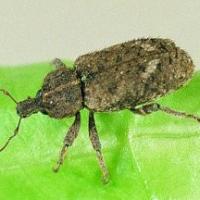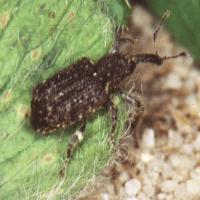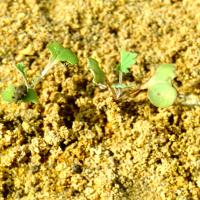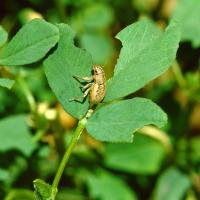Diagnosing weevils in canola
Weevils are beetles with long snouts that can damage or kill young seedlings. Species that damage canola include: Vegetable weevil, more common in high rainfall areas and often next to trees or bush; desiantha weevil (also known as spotted vegetable weevil) is widespread; Small lucerne weevil and Fuller's rose weevil mainly occur on the south coast.
What to look for
- Areas of chewed and lopped canola seedlings.
- Damage from vegetable weevil is usually worst next to paddock edges and bush areas, or parts of the paddock that had capeweed in the previous year.
Paddock
- Chewed seedling leaves, petioles and stems.
- Stems may be severed causing rapid death.
- Leaves have crescent shaped pieces removed, giving them a serrated appearance.
Plant
- Weevils are generally grey and often hard to find.
- Vegetable weevil is about 10mm long with two short white stripes at an angle on each side of its abdomen.
- Desiantha weevil is about 5mm long, dark coloured and sometimes has grey flecks on its back.
- Small lucerne weevil is about 5mm long, light grey in colour with a white stripe on each side.
- Fuller’s rose weevil is about 8-10mm long but has yellow stripes on its side and back.
Insect Adult
What else could it be
| Condition | Similarities | Differences |
|---|---|---|
| Diagnosing vegetable beetle damage | Chew stem, petiole, leaves and sever the seedling stem | Weevils can cause scalloped leaf damage and have characteristic long snouts. They are usually found in the vicinity of the damage |
| Diagnosing cutworm in canola and pulses | Chew stem, petiole, leaves and sever the seedling stem | Weevils can cause scalloped leaf damage and have characteristic long snouts. They are usually found in the vicinity of the damage |
| Diagnosing false wireworm | Stem ringbarked, sudden plant death | Weevils also chew leaves and petioles, weevils hidden nearby |
Where did it come from?
- With the exception of Vegetable weevil, the weevils are flightless and remain in the paddock during their life cycle. Adults eat canola and a range of broadleaf weeds, particularly capeweed. Adults emerge from the soil in spring to early summer and survive by hiding in soil litter, under stones, plants or clods. Eggs are laid into the surface of the soil and hatch when there is sufficient moisture for plant germination. Desiantha larvae feed on grass, and cereal seedlings.
- Vegetable weevils rarely fly but adults rest in the soil in bush or paddock edges during summer. They are attracted to any paddock that has capeweed present, and after capeweed germination move into the paddock to feed and lay eggs. The eggs hatch into green larvae in early winter that feed on the plants on which they hatched. The adult weevils also move into the edges of canola paddocks soon after crop emergence to feed.
Management strategies

Spraying insecticide

Green bridge control
- An insecticide border spray at crop emergence will help to control vegetable weevil before it moves into the crop. Paddock boundaries should be checked every few days until the crop has four to five true leaves.
- Desiantha, small lucerne and Fuller’s rose weevil are not controlled by border sprays as they tend not to migrate out of paddocks.
- Paddocks that had desiantha weevil larvae damage cereals in the year before will have desiantha weevil adults present in the current year.
- Weevil numbers in crop can be reduced by controlling plant hosts, for example, cape weed, before the canola is sown.
- Spray 'green break' summer weeds.
How can it be monitored?
- Check paddock boundaries every few days for vegetable weevil incursion until the crop has 4-5 true leaves.
Page last updated: Thursday, 7 September 2023 - 2:55pm






